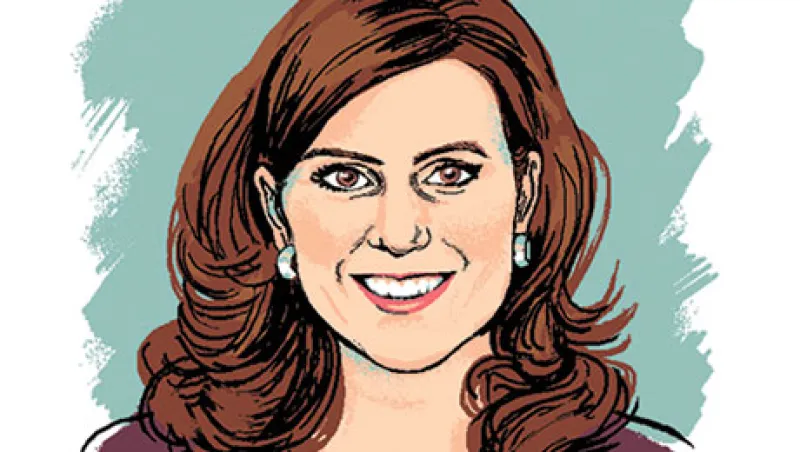Just six months after she landed her dream job and became president and CEO of the asset management arm of Wells Fargo & Co., Kristi Mitchem found herself confronting an executive’s worst nightmare. Regulators charged her firm’s parent bank with fraudulently opening millions of unauthorized deposit and credit card accounts to meet sales quotas and imposed hefty fines totaling $185 million. Though the imbroglio had nothing to do with her job, Mitchem — who had headed the Americas institutional client group at State Street Global Advisors (SSGA) — started contacting clients to assure them that the asset management division was not involved in the scandal.
Still, the headline risk generated by the parent’s woes posed a problem for public pension and other institutional clients that are required to reevaluate money managers at such times. Mitchem has been communicating with institutional clients since September about the steps Wells Fargo is taking to prevent a repeat of the sales problems, including establishing a new group to improve oversight and best practices across the company. But the episode, while a distraction, hasn’t stopped Mitchem from making progress with the strategy she was hired to implement.
Although Wells Fargo Asset Management (WFAM) is large — it has $481 billion in assets, run by 29 independent teams, and is the 20th-largest asset manager in the U.S. — Mitchem says it’s not too big and entrenched to take bold steps with its business lines and try new ideas; she says this is at the core of her plans.
“I want to challenge the status quo,” Mitchem says. “Look at the problems out there, like not meeting the needs of 401(k) investors or the lack of confidence and trust that people have in investment managers. I think this industry requires innovation and disruption.”
Wells Fargo is putting resources into a serious growth plan for the money manager. “There is this notion that bank-owned asset management doesn’t work,” Mitchem says. “But that’s wrong. Banks are able to put capital behind their ideas.”
Mitchem, a Fulbright scholar who holds an MBA from Stanford University, was well prepared for her role at Wells Fargo. At SSGA she developed a strategy for the institutional client group in the U.S., Canada, and Latin America. Before that she ran BlackRock’s U.S. defined contribution group after the New York manager’s purchase of Barclays Global Investors. At BGI she was in charge of U.S. transition services.
Mitchem’s first task at Wells Fargo has been integrating Analytic Investors, a quantitative shop the bank acquired in August. Before the purchase, which added $15 billion in assets, WFAM was the only major bank-owned manager without a quantitative division. That left it without the ability to offer smart beta, or factor-based, investments and compete with the likes of Goldman Sachs Asset Management, J.P. Morgan Asset Management, and Northern Trust Asset Management.
Mitchem hired Nicolaas Marais, who had run multiasset investments at Schroders, to head WFAM’s $40 billion multiasset group. Marais, who worked with Mitchem when both were at BGI, plans to hire more people and develop systems and technology — in particular, to blend investments from the 29 different teams within WFAM.
Mitchem is expanding WFAM’s ESG (environmental, social responsibility, and governance) investments. ESG is important to the Wells Fargo executive, who at SSGA developed SHE, an exchange-traded fund that tracks an index of companies with a significant number of women in senior leadership and board positions. SHE was seeded by the California State Teachers’ Retirement System; though it’s still early days for Mitchem’s ESG vision for Wells, she would consider forming similar partnerships with big investors like CalSTRS. Wells also wants to be able to determine the ESG factors and risks that are present in investors’ portfolios.
“One of the areas that is underappreciated is knowing the footprint of what you’re investing in,” Mitchem says. “Maybe you have a big carbon footprint. Knowing this will become increasingly important.”
The WFAM chief also is working on building closer ties with other businesses within Wells Fargo’s wealth and investment management division, which WFAM joined last year after it was moved out of wholesale banking. One example of this: developing low-cost, factor-based portfolios that would be of interest to clients of the wealth advisory business.
Mitchem is focusing her attention on refining WFAM’s defined contribution offering, including more-thoughtful use of the data on participants in these plans.
All active asset managers, however, are pressured by the continued popularity of low-cost index funds. Mitchem insists that the active-versus-passive debate is important but cyclical. She thinks the best managers will evolve from offering every possible investment into counselors of sorts. “I want to know my clients in an in-depth way so I can create an answer,” she says. “I want us to be the world’s best problem solver.”







